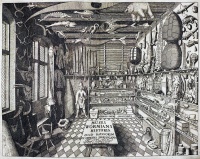Book frontispiece
From The Art and Popular Culture Encyclopedia

|
Related e |
|
Featured: |
A frontispiece in books generally refers to a decorative or informative illustration facing a book's title page, being the verso opposite the recto title page. While some books depict thematic elements, other books feature the author's portrait as the frontispiece.
The word originates from the French word frontispice, which was originally an architectural term referring to the decorative facade of a building. In the 1600s, the French term came to refer to the title pages in books, which were often decorated at the time with intricate engravings that borrowed stylistic elements from architecture, such as columns and pediments. Over the course of the 16th century, the title pages of books came to be accompanied by illustrations on the facing page and the term took on the meaning it retains today as early as 1682. By then, the English spelling had also morphed from frontispice to frontispiece.
See also


